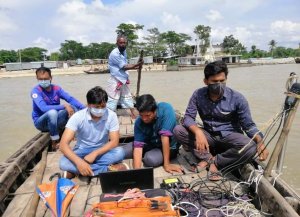
What is the Digital Hydrographic Survey?
Moreover, The branch of science that deals with the Geography of Submersed areas such as rivers, canals, beels, seas, oceans, etc. Similarly, Submerged areas, amount and level of water, amount of flow, location of Soundings points, and preparation of Seafaring lists. But also, They call this a Digital Hydrographic survey.
Additionally, People use it for survey work in docks, harbors, and Coastlines, as well as for Hydroelectricity and water supply.
Objectives of the Digital Hydrographic Survey
01. Digital Hydrographic Determine the position of the coastline and notice its change in direction.
02. As a result, Notice the origin and change of the beach.
03. Determining the extent of soil erosion and siltation and marking its area.
04. Sounding to determine the characteristics of the bottom of a submerged area.
05. Determining the depth of water for navigation and determining the amount of soil to be cut for
navigability in the waterway.
06. Determine the direction of water flow, speed characteristics.
07. Determine the drainage capacity of the river Digital Hydrographic Survey.
08. Determining the average sea level including preparing a list for determining and controlling the amount of tidal time.
09. Furthermore, To determine the location of the buoy, lighthouse, shelf, and mountain range in the middle of the sea for the safety of navigation.
10. Determine the highest and lowest levels of water surface.
11. Determine the area of contour and cross-section of the submerged area.
12. Determine the holding capacity of the closed reservoir Digital hydrographic survey.
Importance of Hydrographic Survey
The importance of a Digital hydrographic survey in Bangladesh is immense. The reasons are as follows:
01. Specifically, Bangladesh is an island-like and riverine country. Likewise, Numerous rivers, canals, and canals flow over it like a net and fall into the Bay of Bengal surrounded by the southern region.
02. Similarly, Due to its geographical location, most of the rainwater of this sub-continent flows over Bangladesh, causing most of its area to flood every year and stay underwater for a long time.
03. Moreover, Under the soil of this country, there are valuable natural resources like coal, limestone, natural gas, oil, etc.
04. Furthermore, Knowing the nature of the subterranean terrain is necessary for implementing co-engineering projects such as roads, railways, bridges, culverts, flood control, etc.
05. But also, The importance of Digital hydrographic surveys for the development and maintenance of postal, seaport, or river port activities in this country are immense.

Methodology of Hydrographical Survey in the River:
Likewise, We used Echo-sounder SDE–28 instruments for conducting the Digital Hydrography Survey in the river. Similarly, We placed the instrument on an ordinary motorized country boat along with a GPS ranging pole and Transducer as shown in the sketch.
Additionally, We connected the GPS ranging pole and Transducer with the Echo-sounder SDE – 28. We fixed the GPS Base at the shore. Similarly, The GPS Base had been fixed at shore. GPS gave the position i.e. latitude & longitude and Echo-sounder reflected the depth.
Specifically, All data had been automatically plotted in the machine with the help of Navigation / Digital Hydrographic survey software. But also, GPS connected our known pillars which had already kept on both the banks. Final output had been obtained from our computer & plotter. Similarly, The boat moved along the path as shown in the sketch
Methodology of Hydrographical Survey in the River:
Digital Hydrographic survey is the science of measurement and description of features that affect maritime navigation, marine construction, dredging, offshore oil exploration/ offshore oil drilling, and related activities.
In fact, Our company offers quality Digital Hydrographic Survey Services, which meets the various requirements of our clients. In this type of survey, we study the physical properties, distribution, circulation, and quantities of the water bodies.
The latest instruments and sophisticated techniques are employed in delivering the Digital Hydrographic services.
